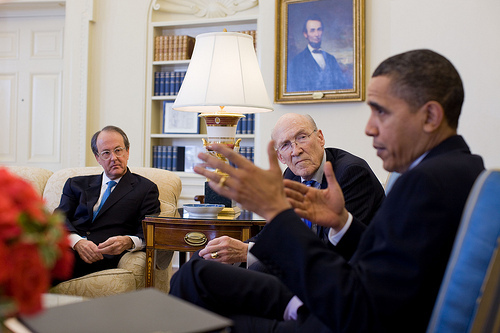| Home | About | Archives | RSS Feed |

@theMarket: Break Out
 It would appear that November's pull back in the stock market is over. From top to bottom, the S&P 500 Index lost 4.5 percent and regained 3 percent of that in just the last two days. That feels to me like a break out.
It would appear that November's pull back in the stock market is over. From top to bottom, the S&P 500 Index lost 4.5 percent and regained 3 percent of that in just the last two days. That feels to me like a break out.
Having gone from oversold to overbought in less than one week, I would suspect that a small dip in the averages is warranted, but that would only be an opportunity to buy in my opinion. Last week, I advised investors not to be too worried about last week's sell-off. I had a hunch that new data would indicate that the economy is improving. That turned out to be the case. I expect a continued stream of better news on the economy over the next few months that will surpass most investor's expectations.
In my last column, I wrote that "the only possible fly in the ointment I see right now is the failure of Congress to act on the looming expiration of the Bush tax cuts." I implored readers to put their legislators on notice that the tax-cut extensions were their No. 1 priority. Washington must have been reading my columns because on Monday morning both parties met and began working on that extension. With luck, it looks like a compromise could be reached before Christmas.
At the same time, the president's deficit reduction team presented a variety of far-reaching ideas to cut the deficit (see Thursday's column "And Now for That Deficit"). Between those developments stateside, plus the potential bailout of Ireland as well as some strong industrial production numbers from China, set us up for a rally.
Although we have yet to break above April's highs in the S&P 500 Index, over on the NASDAQ we have breached that barrier, as has the Dow. The consumer discretionary, industrial, energy and materials sectors have all broken out to bull market highs as well this week. These sectors all appear to be in a solid uptrend, despite looking a bit extended on a short term basis. Financials continue to move sideways as do some of the more defensive sectors such as utilities, health care, consumer stables and telecom.
Bullish sentiment has also been rising but is still below 50 percent, although next week's figure from the American Association of Individual Investors may show a bigger increase after this recent rally. As a contrarian indicator, bullish sentiment is not yet at worrisome levels.
Remember too that the bulls have the wind at their backs. The economy is growing, (despite the high unemployment rate) as businesses begin to invest in plant and equipment. Although the housing market is bumping along the bottom, it is at least stabilizing, and exports are growing thanks to the weakening dollar. Finally remember that Fed Chairman Ben Bernanke is on record in wanting stock prices higher (see "Don't Fight the Fed" ). All in all, that is a powerful combination that should drive the markets higher. How high?
On the S&P 500 Index 1,300 is a good round number. That's a potential gain that might even entice some of those investors sitting in bonds to come out and play in the equity markets. As for where I see the most potential gains: emerging markets, mines and metals, energy, technology and possibly real estate are my bets.
Bill Schmick is an independent investor with Berkshire Money Management. (See "About" for more information.) None of the information presented in any of these articles is intended to be and should not be construed as an endorsement of BMM or a solicitation to become a client of BMM. The reader should not assume that any strategies, or specific investments discussed are employed, bought, sold or held by BMM. Direct your inquiries to Bill at 1-888-232-6072 (toll free) or e-mail him at wschmick@fairpoint.net. Visit www.afewdollarsmore.com for more of Bill's insights.
| Tags: tax cut, deficit, housing |
The Independent Investor: And Now For That Deficit
|
President Obama speaks with Erskine Bowles, left, and former Sen. Alan Simpson in February before announcing their appointment to the deficit-reduction commission in this White House photo. |
The lame-duck Congress is finally getting to work. The president is horse trading with the Republican majority to extend the bush tax cuts before the end of the year. At the same time, the Obama budget deficit commission has released its findings and the full 18-member panel will vote on these proposals on Friday. Be prepared for some fireworks.
When the President Obama first appointed the bipartisan panel led by Erskine Bowles and former Sen. Alan Simpson, to come up with ideas to cut the exploding deficit, I wrote that we would have to wait until after elections before their findings would be revealed. Given some of the radical suggestions these deficit doctors have suggested I can understand why they are only now being revealed.
At long last the "untouchables" are on the table; those sacrosanct programs that no politician has had the guts to address in my lifetime. Taboo subjects such as Medicare, Medicaid, Social Security, farm subsidies, defense spending and mortgage interest rate deductions are on the table. If accepted in its entirety (and it won't be), the plan would reduce the deficit by $3.89 trillion between 2012 and 2020. The current national debt is about $13.9 trillion.
Here are some of the high points. Our complicated tax system and tax brackets would be collapsed into three brackets – 12, 22 and 28 percent. Itemized deductions would be eliminated; capital gains would be taxed as ordinary income. Contributions to tax-deferred accounts would be capped at 20 percent of income or $20,000, whichever is lower.
Although the plan would reduce income tax rates, there would be a price to pay. Your mortgage interest deduction would disappear, gas would be taxed at a higher rate, the retirement age of Social Security would increase and benefits for both Medicare and Medicaid will be cut. Over on the corporate side, taxes would be reduced as well to 28 percent from 35 percent. But employer provided health care exclusions would be capped and phased out altogether by 2038.
Now before you take sides on what you like or dislike about the proposals, understand that just about every interest group, every age group, every demographic profile you can come up with will both gain and lose by these proposals. Lobbyists will trash those proposals that threaten their clients and promote those that don't. On an individ

